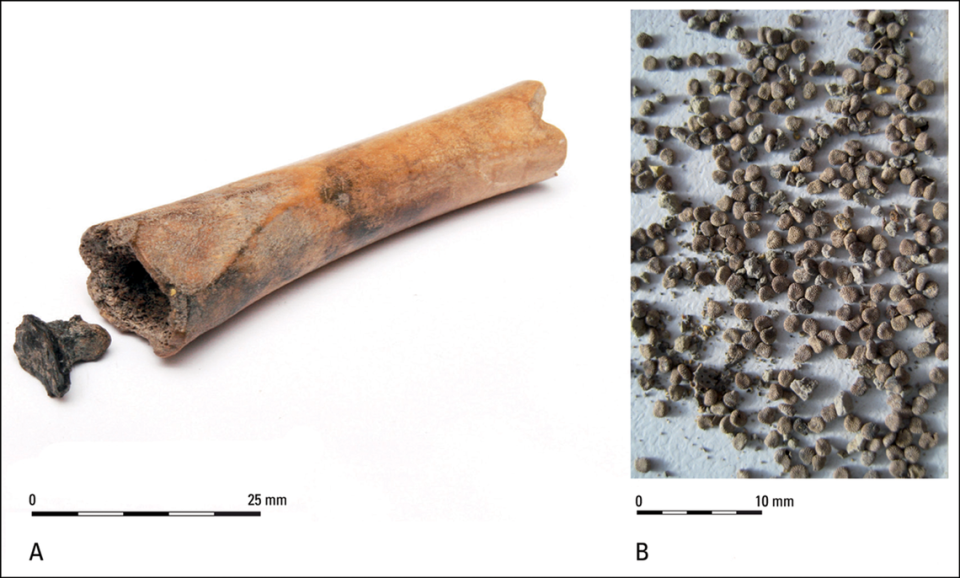1,900-year-old bone — filled with hallucinogenic seeds — is ‘rare’ find. What’s it for?
About 1,900 years ago, someone in what is now the Netherlands hollowed out a sheep or goat femur, filled it with poisonous, hallucinogenic black seeds and sealed it with tar. Eventually, the bone ended up in a pit as an offering.
Now, archaeologists exploring the Houten-Castellum site — a “unique” ancient settlement that was inhabited between about the sixth century B.C. and the second century A.D. — have unearthed the bone, according to a study published Feb. 8 in the journal Antiquity.
The animal bone is a “rare” find and an important discovery: It’s the “first conclusive evidence for the intentional use” of black henbane, a poisonous plant belonging to the nightshade family, in the Roman world.

Uncover more archaeological finds
What are we learning about the past? Here are three of our most eye-catching archaeology stories from the past week.
→ Cache of coins was hidden in a box underground for 850 years — until now
→ 1,300-year-old armor — with bow, arrows and sword — found under war horse remains
→Tomb hid under jungle floor for 1,700 years — until now
Black henbane plants are “extremely poisonous” but “can also be used as a medicinal or psychoactive drug,” archaeologists said. The species is indigenous to Europe and Asia, and while it is not commonly found today, it once thrived among ancient settlement areas “on dunghills and in nutrient-rich locations in vegetable gardens.”
Evidence of black henbane in ancient settlements dates back as early as 7,500 years ago, when experts believe people were already using the plant for its “psychoactive properties.”
Historical accounts from ancient writers indicate that despite its known hallucinogenic and poisonous effects, black henbane also had medicinal properties, the researchers said in a Feb. 8 news release from the Freie Universität Berlin.
The plant could remedy ailments such as “fever, cough and pain,” experts said.
Archaeologists have long struggled to study the use of the plant, Maaike Groot, who led the team of archaeologists, said in the release.
“Since black henbane can grow naturally in and around settlements, its seeds can end up in archaeological sites simply by chance,” she said. “This makes it difficult to prove if it was used intentionally by humans – whether medicinally or recreationally.”
At the Houten-Castellum site, archaeologists found traces of black henbane, but only two of them appeared to be intentional, according to researchers.
Aside from the seed-filled bone, experts also unearthed a full black henbane plant that was buried as an offering along with four cooking pots and some kind of basket or trap, they said. However, experts noted it is not impossible that the plant was not intentionally placed in the offering, and instead ended up there by chance, as Groot explained.
The hollowed bone, however, likely served as a container for black henbane, indicating that humans intentionally stored and used the seeds, researchers argued.
“The fact that, in our case, the seeds were found inside a hollowed-out sheep or goat bone sealed with a black birch-bark tar plug indicates that the henbane was stored there intentionally,” Groot said.
Archaeologists said when they found the bone, it held about 1,000 seeds, but in the process of unearthing the artifact, only about 382 of the seeds were preserved. If filled to its maximum capacity, the bone could probably hold around 4,000 seeds, experts said.
The discovery marks the fifth example of intentional ancient black henbane use in north-western Europe, according to the university. Only one of the other examples, which dates to the medieval period and was found in Denmark, was found in a container like the Houten-Castellum discovery.
Houten is about 30 miles southeast of Amsterdam.
Mummies with traces of psychedelics reveal ancient rituals in Peru, study shows
‘Unusual urn’ — still filled with 3,000-year-old human remains — found in burial mound
2,200-year-old bronze artifacts — including 7 swords — unearthed in China. See finds

